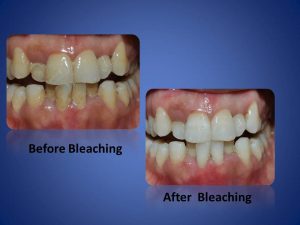Teeth Whitening
Teeth whitening is almost synonymous with bleaching, though both procedures are not completely the same. Nevertheless, both methodologies are indeed a swift, effective and non-invasive (requiring no tooth preparations or cutting of you teeth) way to enliven your smile.
Dental Studio offers you various Bleaching regimens to suit your requirement, availability of your time, or budget. We could provide you with Laser Assisted Bleaching sessions that would take half an hour to an hour, or instruct you and provide you with home-use bleaching kits too.

The United States Food and Drug Administration terms "bleaching" as a procedure that leads to whitening of teeth beyond their natural colour. The bleaching procedure uses products that contain hydrogen peroxide or carbamide peroxide among the total other ingredients like flavouring agents and those intended to soothe tooth sensitivity.
On the other hand, the term “Whitening", pertains to the removing of stains, debris or tarnish and restoring a tooth's natural colour. This is done by the professional use of dental prophy and abrasives. A series of whiteners could be used including dental prophy paste or an abrasive powder or a mild etchant.
The surface of the teeth can get stained externally on consumption of aerated drinks (black or orange) and beverages such as coffee and also certain foods such as those containing turmeric and tobacco. These stains get particularly accentuated or prominent on areas of routine wear due to brushing or erosion of the calcium of teeth because of acids from ones’ stomach or from acidogenic foods. Superficial stains can be easily removed with dental prophy brush or cups through prophylactic dental cleaning. However deep set, stubborn and tenacious stains such as those mentioned, coupled with wear of teeth and acid erosion necessitate abrasive prophylactic efforts combined with bleaching too, and perhaps need more than one session to achieve good results.
Discolouration in the interior of teeth is called Intrinsic. Intrinsic stains occur subsequent to trauma (can cause darkening of the dentin), intake of certain medications (like tetracycline antibiotics or excessive fluoride) during the formative stages of teeth development (mother’s intake in the womb or during 1-2 years of an individual’s age), or due to aging. As with aging the enamel wears thin and its inherent transparency allows the colour of the dentin which is more yellowish in colour to show through. Bleaching, however, can alter the transparency and smoothness (crystalline nature) of the enamel, and therefore alter or increase the reflection of light by enamel and thereby lighten the overall tooth colour.
We at Dental Studio, would first need to examine you before we could tell you the nature of your tooth colour, whether it is extrinsic (superficial) or intrinsic (deep set) and then we could decide on a suitable methodology of bleaching and prescribe the regimen of how many sessions would be necessitated.
Post Bleaching Care
After bleaching the following recommendations are given and longevity of the whitening effect will depend on your compliance:-
1. Avoiding aerated drinks (black and orange) and beverages such as coffee for at least 10 days to a fortnight after whitening. After which it is advisable to sip aerated drinks or beverages with a straw
2. Having Oral Prophylaxis at our office routinely every 3 months
3. In some cases we also recommend a home bleaching as follow-up maybe at least once a year.
4. Maintaining good oral hygiene by brushing and flossing after meals and especially at bedtime.
Statement of Limitations
1. Bleaching cannot give you results of "unnaturally" white teeth.
2. It is advisable to wait approximately two weeks after bleaching to see final results, particularly if you are to have ceramic restorations on other teeth and want the colour matching of the restorations to be corresponding well to that of your newly bleached teeth.
3. Other Tooth-coloured restorations will perhaps need replacement after bleaching.
4. Teeth roots will not bleach and turn white. The whitening effect is limited to the crown portion. In individuals with gum problems and recessed gums as a consequence of that gum disease (periodontitis) their root surfaces will appear yellowish at the gum line.
5. Bleaching or Teeth Whitening is not a permanent solution. The stains will come back, if you smoke or consume a lot of staining foods or aerated drinks or beverages. If you avoid these sources of staining, you may not need another whitening treatment for around 12 months.
Contraindications
Pregnant or nursing women are not advised to undergo teeth whitening. The potential impact of inadvertent swallowing of even diluted bleaching material on the unborn baby in the womb or on the baby through breast feed is not yet verified.
